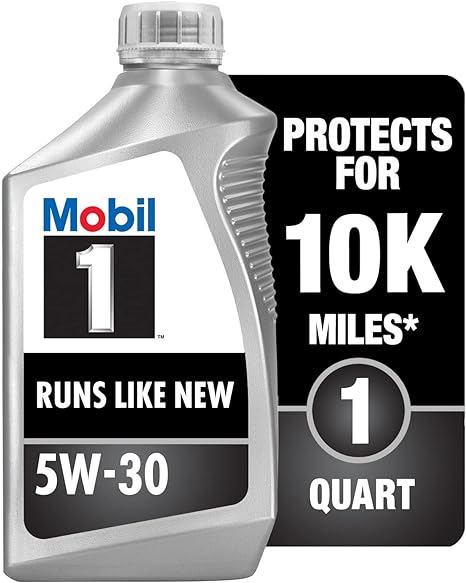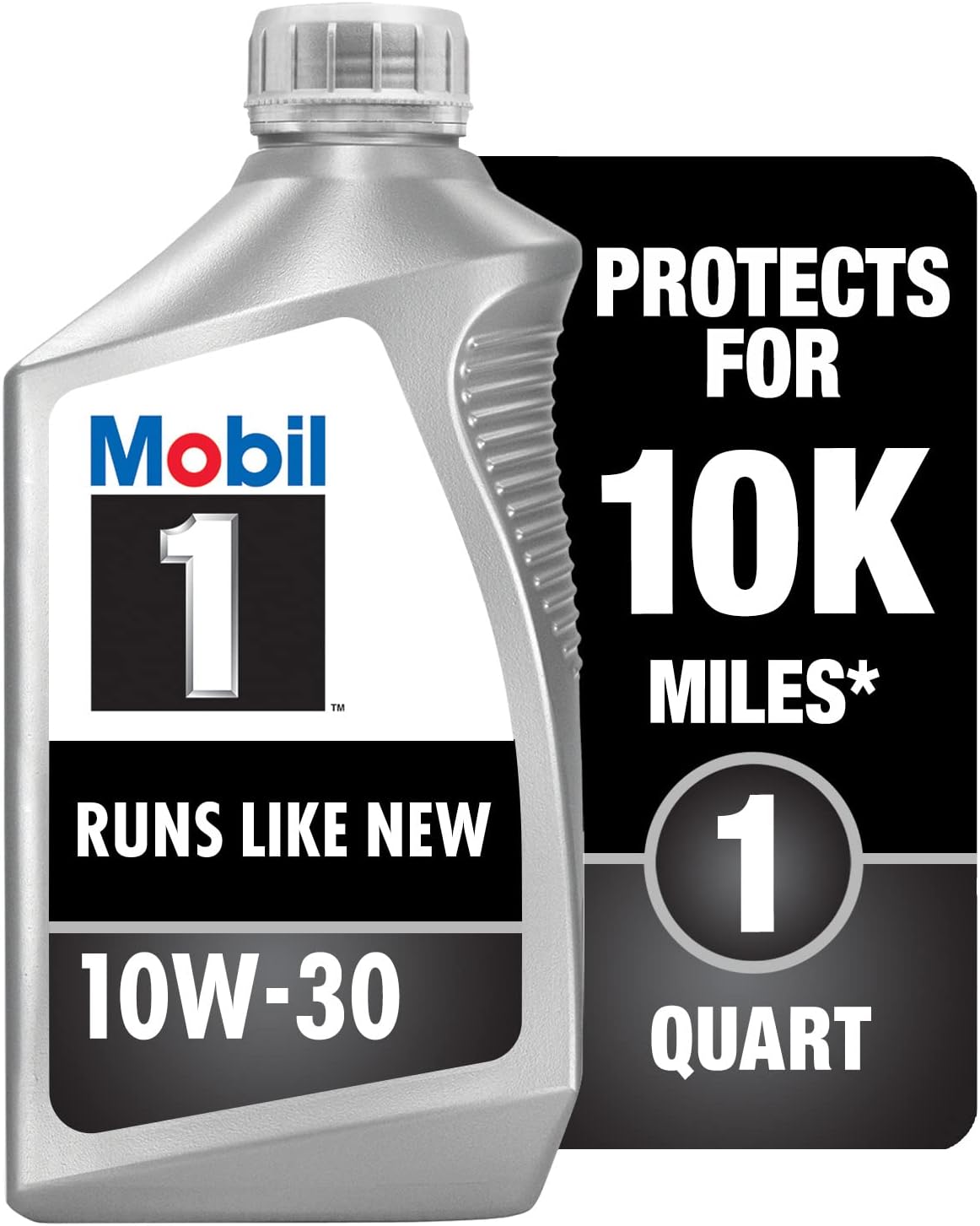The motor oil is a central component, serving plenty of crucial functions that improve the operations and, eventually, the vitality of the engine. Oil recommended by the manufacturer is definitely a prior choice for better performance. Contrary to this, mixing two different oil grades is another way often adopted. However, it is critical to examine if the combination of the two is safe to go. Many critical factors need to be considered before mixing two oils, including operating temperatures, viscosity, additives, and mixing ratios. Prior to getting into the profound depth, take a breath and have insights into the differences between 5w-30 and 10w-30.
Disparity Between 5w-30 and 10w-30 Motor Oils

Mobil 1 Advanced Full Synthetic Motor Oil 10W-30

Mobil 1 Advanced Full Synthetic Motor Oil 5W-30
Before heading towards the differences between 5w-30 and 10w-30, it is significant to understand the confidential connotations that their names harbor. The first numerical value in the 5w-30 and 10w-30 depicts the viscosity measure specifically at lower temperatures, and the numeric value after the letter “w” reflects the level given to the viscosity at functioning temperature.
To make it more straightforward, take 5w30. By 5w30, it means it possesses the viscosity measure of 5 at lower temperatures; what does it mean? It signifies that at lower temperatures, it has a lower viscosity as compared to that of 10w-30, which has a viscosity measure of 10. The more viscous the oil is, the more difficult it is for the oil to flow. Less viscous oil fluidizes the associated parts and performs the destined tasks optimally.
Concluding the differences, there is no doubt in saying that the major difference lies in the lower temperature range that brings further differences. But, if we compare both the oils at operating temperature, there’s no big difference between the two.
Primary Concerns for Mixing Two Distinct Oils
In order to ensure compatibility, complete blending, and safety, many concerns are necessary to look into to avoid future tribulation. Out of many, the most important are:
- Viscosity
- Temperature Range
- Additives
- Mixing Ratios
Viscosity
One of the most influential factors contributing to the thorough blending is the viscosity coherence. Viscosity is a measure of flow resistance for any fluid. Two fluids with the same viscosity tend to blend more rigorously, enhancing the effectiveness and performance. Fortunately, the viscosity of 5w-30 and 10w-30 at operating temperature is identical, ranked 30.
Temperature Range
There are several critical aspects that readily depend on the functional temperature range. Flow traits and viscosity directly vary with the temperature. If we compare the temperature range of 5w-30 and 10w-30, the lower temperature range is slightly different and presents a larger working gap. But for normal operating temperatures, both oils share a common temperature range.
Additives
Oil additives are typically used to enhance the lubrication and increase the performance. The problem arises when the two oils we will mix are from different manufacturers. Every company has its own selection of additives, and the two oils can possibly be suspended because of entirely different lubricants that may hinder the all-out mixing.
Blending Proportions
The ratios in which the two oils should mix to get a better performance vary from vehicle to vehicle and from climate to climate. There are some properties that one oil encloses, while the others are enclosed by the second one. In order to achieve a certain viscosity and performance, the ratios should be taken accordingly. Also, the temperature of the area where you are located greatly influences the ratio. For instance, 5w-30 is a more suitable choice for colder regions as compared to 10w-30, which has more viscosity and, hence, less performance.
Can You Mix 5w-30 and 10w-30? – Safety Aspects

Considering the most critical concerns while mixing the two oils, 5w-30 and 10w-30 are safe and compatible to mix together. The discrepancy occurs when there is a sharp difference in the viscosities of two fluids that retards the thorough mixing. As the viscosities of 5w-30 and 10w-30 are ranked the same at the operating temperature, mechanically, they are uncontroversial to mix for the engine and its efficiency.
However, the following are some circumstances that can diminish the performance if not regarded properly:
- If the combination of oil is not creating any rapid problems, it is not a guarantee that long-term use will also be a safer approach.
- Mixing different oils from different brands doesn’t allow the mixture to mix homogeneously because of the incompatibility of additives poising inside them. This inhomogeneity can impair the performance of an engine.
- Going for the mix of two oils is never suggested when your vehicle is under warranty. Nourish your engine with the prescribed fuel for the best functioning, or you will have a potential risk of losing its health as well as the warranty.
- Make sure to have a consistent ratio mix by keeping in mind the requirements of your engine and vehicle.
Effects of Mixing 5w-30 and 10w-30 Oils
When we mix 5w-30 and 10w-30, there is no immediate damage, but prolonged use can cause damage to your engine and also reduce the oil changing gaps. The reason behind diminished performance and reduced gaps lies in unmingled additives from different grade oils.
The mixing of 5w-30 and 10w-30 is appropriate for the engine in lubricating the components, but at lower temperatures, there are anomalies. Also, the 5w-30 holds less viscosity, which relates to the easy flow and lubrication even at a lower temperature. While the 10w-30 is more viscous but definitely more suitable for heavy loaders.
Moreover, the hydrocarbon structure is different for both oils. When we mix the two, it may result in the expulsion of gases. This ouster can damage the hydraulic filter and valves.
Momentous Scenarios that Demand the Mixing of 5w-30 and 10w-30
The mixing of 5w-30 and 10w-30 doesn’t cause any harm, but at the same time, it is not recommended to use the mix of two oils for a longer period. There are some momentous scenarios where the instantaneous solution is the mix of 5w-30 and 10w-30, and those are:
- In extreme weather conditions, the mix of 5w-30 and 10w-30 provides a wide workable temperature range.
- Driving through an isolated area where the required oil is unavailable, using the mix of 5w-30 and 10w-30 oils is recommended as they don’t have any potential risks.
- To counteract any mishap, leakage, or breakage, you can go for a mix of oils as a transient solution before reaching out to any nearest service station.
Professional Advice and Manufacturer Recommendations
Hopefully, the answer to a frequently asked question, “Can you mix 5w-30 and 10w-30 oil?” is responded. It has been tried and tested that mixing 5w-30 and 10w-30 oil is not damaging, but long-term use of mixed oils can definitely cause harm. Always remember that your vehicle and engine are two costly items; above that, your safety should be the priority. Running after shortcuts to save money or acting upon unprofessional advice can devour your vehicle. Automotive experts always emphasize the use of oil recommended by the manufacturer. Yes, you can go for the mix in emergency situations, but it is not advisable to have it for an extended period.
Related Reads:
- 0W20 Vs 5W20: Detailed Comparison Compare the differences between 0W20 and 5W20 oils to understand how viscosity affects performance, just like in the 5w30 vs 10w30 debate – Learn more.
- SAE 30 Vs 10w-30: Head-To-Head Comparison Explore the differences between SAE 30 and 10w-30 to get a better understanding of oil performance, similar to 5w30 vs 10w30 – Read more.
- Mixing 5w30 and 10w30 Motor Oils: Effects and Safety Explained Learn about the effects and safety of mixing different oil grades, which can inform your decision on using 5w30 vs 10w30 – Find out more.
- Unveiling the Secrets of Engine Oil Blending: Can You Mix 5W-20 and 5W-30? Understand the nuances of oil blending, relevant to comparing the properties of 5w30 and 10w30 oils – Explore here.
- Valvoline vs. Pennzoil Face-off: Narrowing Down the Best Engine Oil Discover how Valvoline and Pennzoil oils compare in terms of performance, helping you decide between 5w30 and 10w30 – Discover now.
We’d love to hear from you!
Enjoyed our blog? Please leave a comment below. Whether it’s questions, feedback, or sharing your experiences, your input is highly valued!



Pingback: Kirkland Synthetic Oil vs. Mobil 1